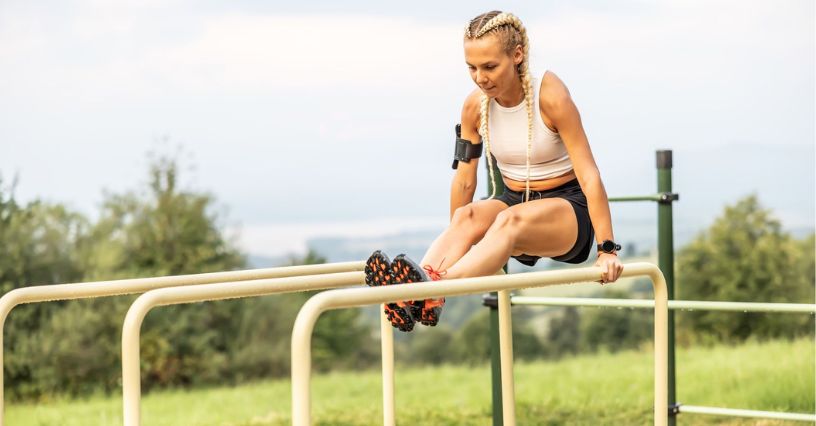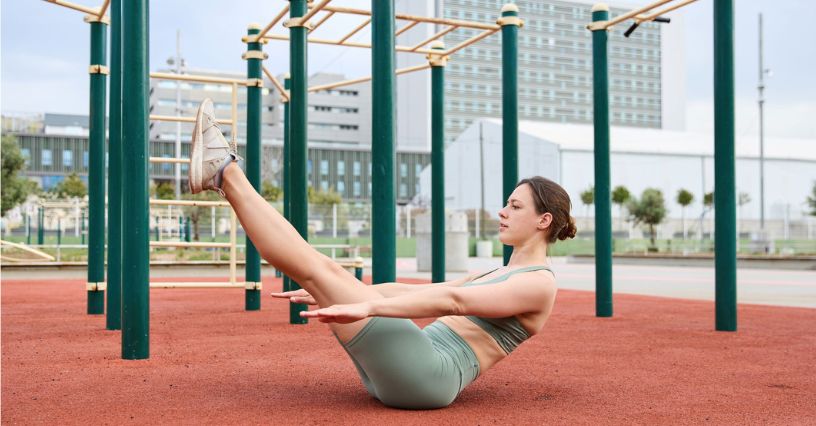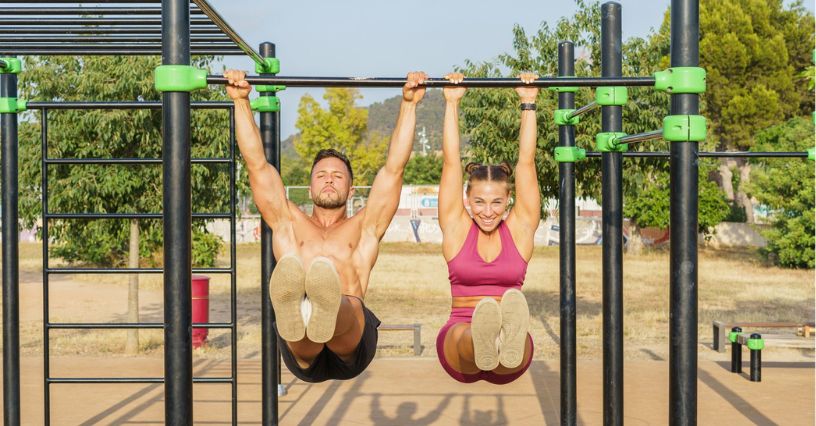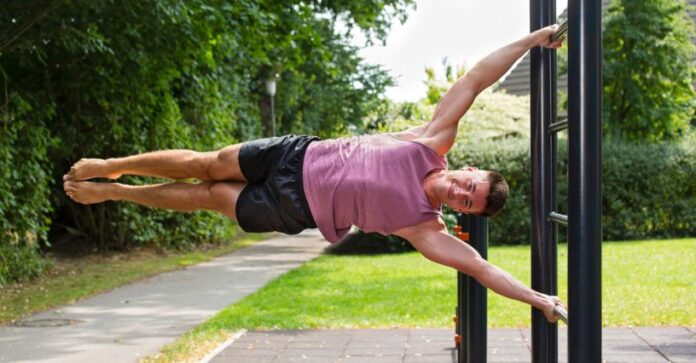How do you build a physique that impresses with natural strength, without expensive equipment or a gym membership? The answer is: calisthenics. This form of training primarily uses your own body weight and only requires a little free space, regularity, and the right action plan. Here are some tips on how to get started with calisthenics, which exercises to introduce at the beginning, and how to avoid the most common mistakes.
What is calisthenics?
The word calisthenics in Greek is a combination of the words kallos – beauty and sthenos – strength, which perfectly captures the essence of this form of exercise – combining the development of strength with harmony and control of movements. Calisthenics is a training method based on resistance exercises in the form of body weight. By training regularly, you will gain not only strength and endurance, but also body awareness and flexibility. You can train at home, outdoors, in open-air gyms, or on the street. It is a form of physical activity for everyone, regardless of their level of experience, as the exercises can be modified to suit their own capabilities.
History of calisthenics
Calisthenics has evolved with man. Since the dawn of time, humans have used their bodies for survival. Climbing, lifting, running, and squatting were essential for hunting, escaping, or building shelter. In ancient Greece and Rome, calisthenics were fundamental to the physical training of gladiators, Spartans, or athletes preparing for the Olympic Games. Simple but effective movements were the basis of daily training.
In the 19th century, calisthenics gained popularity as a method of improving health and fitness in schools. Friedrich Ludwig Jahn, a German educator and the father of gymnastics, popularized bodyweight exercises as part of physical education. In turn, Catherine Beecher, an American educator and author of Physiology and Calisthenics for Schools and Families, introduced calisthenics into women’s education programs. She promoted it as a way to maintain health and well-being.
Calisthenics is experiencing a renaissance in the 21st century, due to, among other things, the development of street training, which combines calisthenics with spectacular acrobatics. Trends that emphasize functional training and natural body development are also important. In addition, calisthenics training is no longer just an exercise, but a lifestyle that combines movement, health, and body awareness. It is appreciated for its simplicity, accessibility, and effectiveness.
Differences between calisthenics and Street Workout
| FEATURES | CALISTHENICS | STREET TRAINING |
| Historical | has its origins in ancient training systems | a modern, subcultural form of training |
| Objective | building muscle strength, general fitness, health, body harmony | acrobatics, spectacular figures, competition |
| Degree of progression | Most exercises are accessible to beginners | Often requires great strength and experience |
| Training location | home, gym, park, beach, etc. | working street squares or parks, open spaces |
| Style | simple, universal | expressive, often combined with music and demonstrations |

Calisthenics – benefits
Calisthenics uses your own body weight as resistance to effectively strengthen your muscles. It trains multiple muscle groups at the same time, which promotes even body development. As a result, the physique becomes naturally proportioned, slim, and sculpted. Multidirectional movements increase the range of motion of joints and improve muscle flexibility. This helps prevent injuries and improve posture.
Each exercise requires control over movements and stability. Regular training improves proprioception (deep sensation). This translates into better coordination and fluidity of movements, but also reduces the risk of injuries and trauma.
Exercises like push-ups, pull-ups, and squats build functional strength—the kind that can be used in everyday activities. Planks or hollow bodies, on the other hand, strengthen the deep muscles that stabilize the spine and influence proper posture. Strong core muscles are essential for health and fitness in everyday life. Calisthenics is also a great way to reduce body fat and maintain a healthy body weight (while maintaining a balanced diet).
Calisthenics allows for unlimited progression. You can increase the difficulty of the exercises, moving from basic movements (e.g., kneeling push-ups) to advanced figures (e.g., standing push-ups). This gives you a sense of satisfaction and motivates you to continue developing.
During a workout, the body releases endorphins – the hormones of happiness. As a result, regular physical activity helps reduce stress, improve mood, and support mental health.
How long does it take to see the effects of physical exercise?
The first effects of calisthenics are visible after just 2-4 weeks, but the full results, such as a significant improvement in strength, a beautifully sculpted physique, or improved physical condition, may only appear after 2-3 months. The effects depend on a number of factors, such as training frequency, intensity, diet, fitness level, and training goal. For lasting and visible results, regularity and patience are essential. Also, do not forget that recovery is essential and adequate amounts of protein, healthy fat, and carbohydrates in the diet.
Contraindications
Calisthenics is a versatile form of exercise that can be adapted to different levels of ability. However, it is not suitable for everyone, especially if you have certain medical conditions or limitations. We are talking, for example, about osteoarthritis, heart disease, high blood pressure, chronic back pain, recent surgery, pregnancy, and postpartum. If you have any doubts about your health, consult a specialist before starting training.

Basic calisthenics exercises
The fundamental exercises of calisthenics training include:
- push-ups – strengthen the chest, triceps, shoulders, and core stabilizing muscles,
- squats – involve the leg muscles (quadriceps, glutes),
- plank – strengthens core muscles, improves overall stability and posture,
- leg exercises – involving the leg muscles (quadriceps, glutes) and the stabilizing muscles of the body,
- pull-ups – mainly work the back, shoulders, biceps, and core muscles,
- dips – to work on triceps, chest, and shoulders,
- glute bridge – responsible for glute strength, lower back, and core,
- Keeping the body empty – strengthens the abdominal and stabilizing muscles.
Calisthenics – how to start?
Before you start training, think about what you want to achieve:
- building strength and muscle mass,
- improving physical condition and endurance,
- lose weight and sculpt your figure,
- learn advanced figures, such as the floor, hand walk, or front lever (weight tilted forward).
Knowing what you want to achieve will make it easier to tailor a training plan to your needs. Now is the time to assess your fitness level.
With the help of a simple test, determine your current fitness level. This will help you choose the right exercises and avoid getting discouraged by a plan that is too difficult or an injury due to overexertion.
How many correct push-ups can you do?
Squats are one of the basic calisthenics exercises that are great for demonstrating your upper body strength and control of your own body weight. Perform as many repetitions as you can while maintaining proper technique:
- 0-10 reps – beginner level: focus on developing core strength – start with push-ups on your knees or against a wall,
- 10-20 repetitions – intermediate level: you can include classic push-ups in your plan,
- 20+ reps – advanced level: you can try more difficult variations, such as diamond push-ups, with legs raised, or on one hand.
Can you stand up for once?
The pull-up bar is one of the most challenging calisthenics exercises, engaging the muscles of the back, shoulders, and abs. It’s also a great indicator of upper-body strength. Try performing a pull-up with your palms facing forward and your thumbs facing each other:
- 0-5 pull-ups – beginner level: start with support exercises, such as negative pull-ups (lowering the bar), pull-ups with resistance bands, or low bar rowing,
- 5-12 pull-ups – intermediate level: continue to do pull-ups regularly, increasing the number of repetitions,
- 12+ pull-ups – advanced level: you can try more difficult variations, such as wide-grip pull-ups, weighted pull-ups, or archer-style pull-ups.
How long can you maintain the correct plank position?
The plank is a key exercise for strengthening your core (stabilizer) muscles, which play an important role in calisthenics. Perform the plank on your forearms:
- up to 20 seconds – beginner level: Core muscles need strengthening. Start with short sets and gradually increase the time,
- 20 to 60 seconds – intermediate level: plank is at a solid level, but work on extending the time and introducing more difficult variations (e.g., plank with leg raises),
- 60 seconds and up – Advanced: Your core muscles are strong. Try dynamic planks (e.g., mountain climber) or exercises that require more stability, such as the side plank.
What happens after the test?
Once you have established your level of physical fitness, adapt your training plan to your ability:
- As a beginner, focus on developing core strength through easier exercise variations and lower repetitions. Avoid complicated movements,
- if you are intermediate, increase the intensity, number of sets, and difficulty of the exercises. Start experimenting with progressions,
- Are you at an advanced level? Introduce advanced calisthenics moves like muscle-ups, planks, or single-arm pull-ups.
Regularity and proper technique are essential in calisthenics. Assessing your capabilities is just the beginning, but consistent work will help you achieve your goals.

How many times a week do you practice calisthenics?
The number of calisthenics workouts per week depends on your level, training goal, recovery capacity, and available time. As a beginner, focus on training 2-3 times per week (e.g., Monday, Wednesday, Friday).
Intermediate exercisers can train 3-5 times a week. You can split your workouts into different muscle groups or exercise types, for example, upper body one day, lower body another day. Advanced exercisers, on the other hand, can train 5-6 times a week. Workouts can be shorter but more intense, focused on specific goals, e.g., progression to difficult moves.
It is important that your training is systematic, well-organized, and adapted to your abilities. Remember that the quality of the exercise and recovery is as important as the frequency itself. On rest days, the body has time to recover and adapt to new challenges. On non-training days, opt for stretching and mobilization, walking, jogging, or cycling.
Calisthenics and useful accessories
Although calisthenics training is primarily based on bodyweight exercises, you can choose a few accessories that will make it easier to learn the technique of certain exercises, increase efficiency, or allow for more advanced versions. Here are some useful tools for calisthenics enthusiasts:
- Pull-up bar – is an essential tool for upper body exercises such as pull-ups and leg raises. For home workouts, you have the choice between wall-mounted or ceiling-mounted pull-up bars with frames. Outdoors, on the other hand, you can use freestanding bars in parks or gyms,
- push-up handles – make it easier to learn and perform classic push-ups, reduce stress on the joints, allow you to work with a deeper range of motion, and can be used for balance exercises,
- gymnastics wheels – require greater muscle stabilization, thus intensively developing strength and body control. Ideal for pull-ups, jumps, L-sits, or planche (keeping the body horizontal, parallel to the floor, only on the hands). Wooden pulleys are the most popular choice due to their comfortable grip,
- push-up tires, which help with learning more difficult exercises, such as pull-ups or jumps. They can also be used for warm-up or mobilization exercises.
- Exercise mat – provides adequate cushioning, which is especially important if you exercise on a hard surface (e.g., tile, wood, or concrete). This protects your joints, knees, wrists, and back, reducing the risk of injury when performing exercises such as squats, planks, push-ups, crunches, etc..
- Weighted vests – will be useful if you want to increase the intensity of your exercises and make faster progress in developing strength and muscle mass. Thanks to the adjustable weight of the vest, you can gradually increase the load depending on your fitness level.
Calisthenics – examples of workouts for beginners
Always start your workout with a warm-up, e.g., 10-15 minutes of light cardio and dynamic stretching, and cool down and stretch after your workout. To start, focus on basic calisthenics that involve the whole body. Do push-ups on your knees or against a wall, squats with narrow and wide legs, planks for 20-30 seconds, and try pull-ups with a resistance band. Gradually, every 1-2 weeks or when you feel that an exercise is too easy, increase the number of repetitions, sets, or difficulty of a particular movement. When you feel pain or fatigue, take a break and rest.
Example workout 1 for beginners:
- squats: 2-3 sets of 12-15 repetitions,
- Increases: 2-3 sets of 10 repetitions per leg,
- classic or knee push-ups: 2-3 sets of 5-8 repetitions,
- lying hip raises (gluteal bridges) – 2-3 sets of 10 repetitions,
- Maintaining the empty body: 2-3 sets of 20 seconds each,
- burpees (drop and rise) – 2-3 sets of 6-8 repetitions.
Example workout 2 for beginners:
- pull-ups: 2 sets of 5 repetitions using an elastic training band,
- Bulgarian squats (foot on a stable height, e.g., chair, box, etc.) – 2-3 sets of 10 repetitions per leg, alternating,
- Jumps on a stable elevation (chair, box, etc.): 2-3 sets of 5-8 repetitions,
- dead bug (dead bug) – 2-3 sets of 16 repetitions (8 times simultaneously release the right hand with the left foot and 8 times the left hand with the right foot),
- skater (lateral jumps) – 2-3 sets of 20-30 seconds each,
- plank – 2-3 sets of 20-30 seconds each.
In short, calisthenics training is simple, effective, and doesn’t require expensive equipment. The key to success is consistency, technique, and choosing the right exercises for your fitness level.



